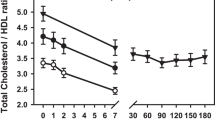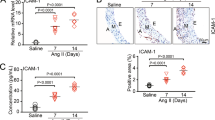Abstract
Prehypertension (blood pressure (BP) 120–139/80–89 mm Hg) is associated with an increased risk for future atherothrombotic events. Although the mechanisms underlying this elevated risk are not completely understood, one possibility is that prehypertension is associated with impaired endothelial fibrinolytic capacity. We tested the hypothesis that vascular endothelial release of tissue-type plasminogen activator (t-PA) is impaired in prehypertensive men. Net endothelial release of t-PA was determined, in vivo, in response to intrabrachial infusions of bradykinin (12.5, 25, 50 ng per 100 ml tissue per min) and sodium nitroprusside at (1.0, 2.0, 4.0 μg per 100 ml tissue per min) in 42 middle-age and older men: 16 normotensive (BP range: 100–119/57–79 mm Hg); 16 prehypertensive (BP range: 120–139/76–89 mm Hg); and 10 hypertensive (BP range: 140–150/74–100 mm Hg). Net release of t-PA antigen was ~25% lower (P<0.05) in the prehypertensive (−0.9±0.8 to 42.4±5.3 ng per 100 ml tissue per min) compared with the normotensive (0.5±1.0 to 53.9±6.5 ng per 100 ml tissue per min) men. There was no significant difference in t-PA release between the hypertensive (−1.8±1.6 to 40.8±6.6 ng per 100 ml tissue per min) and prehypertensive groups. Sodium nitroprusside did not significantly alter the t-PA release in any group. These data indicate that endothelial t-PA release is diminished in prehypertensive men. Further, the level of impairment in t-PA release seen with clinical hypertension is already apparent in the prehypertensive state. Impaired endothelial fibrinolytic function may underlie the increased atherothrombotic risk associated with BP in the prehypertensive range.
This is a preview of subscription content, access via your institution
Access options
Subscribe to this journal
Receive 12 digital issues and online access to articles
$119.00 per year
only $9.92 per issue
Buy this article
- Purchase on Springer Link
- Instant access to full article PDF
Prices may be subject to local taxes which are calculated during checkout


Similar content being viewed by others
References
Go AS, Mozaffarian D, Roger VL, Benjamin EJ, Berry JD, Borden WB et al. Heart disease and stroke statistics–2013 update: a report from the American Heart Association. Circulation 2013; 127 (1): e6–e245.
Huang Y, Su L, Cai X, Mai W, Wang S, Hu Y et al. Association of all-cause and cardiovascular mortality with prehypertension: a meta-analysis. Am Heart J 2014; 167 (2): 160–168 e1.
Vasan RS, Larson MG, Leip EP, Evans JC, O'Donnell CJ, Kannel WB et al. Impact of high-normal blood pressure on the risk of cardiovascular disease. N Engl J Med 2001; 345 (18): 1291–1297.
Williams B . The year in hypertension. J Am Coll Cardiol 2009; 55 (1): 65–73.
Elliott WJ, Black HR . Prehypertension. Nat Clin Pract Cardiovasc Med 2007; 4 (10): 538–548.
Caballero AE . Endothelial dysfunction in obesity and insulin resistance: a road to diabetes and heart disease. Obes Res 2003; 11 (11): 1278–1289.
Quyyumi A . Endothelial function in health and disease: new insights into the genesis of cardiovascular disease. Am J Med 1998; 105: 32S–39S.
Van Guilder GP, Hoetzer GL, Smith DT, Irmiger HM, Greiner JJ, Stauffer BL et al. Endothelial t-PA release is impaired in overweight and obese adults but can be improved with regular aerobic exercise. Am J Physiol Endocrinol Metab 2005; 289 (5): E807–E813.
Parmer R, Mahata M, Mahata S, Sebald M, O'Connor D, Miles L . Tissue plasminogen activator (t-PA) is targeted to the regulated secretory pathway. J Biolo Chem 1997; 272: 1976–1982.
van den Eijnden-Schrauwen Y, Kooistra T, de Vries RE, Emeis JJ . Studies on the acute release of tissue-type plasminogen activator from human endothelial cells in vitro and in rats in vivo: evidence for a dynamic storage pool. Blood 1995; 85 (12): 3510–3517.
Lucking AJ, Gibson KR, Paterson EE, Faratian D, Ludlam CA, Boon NA et al. Endogenous tissue plasminogen activator enhances fibrinolysis and limits thrombus formation in a clinical model of thrombosis. Arterioscler Thromb Vasc Biol 2013; 33 (5): 1105–1111.
Robinson SD, Ludlam CA, Boon NA, Newby DE . Endothelial fibrinolytic capacity predicts future adverse cardiovascular events in patients with coronary heart disease. Arterioscler Thromb Vasc Biol 2007; 27 (7): 1651–1656.
Newby DE, McLeod AL, Uren NG, Flint L, Ludlam CA, Webb DJ et al. Impaired coronary tissue plasminogen activator release is associated with coronary atherosclerosis and cigarette smoking. Circulation 2001; 103 (15): 1936–1941.
Hrafnkelsdottir T, Wall U, Jern C, Jern S . Impaired capacity for endogenous fibrinolysis in essential hypertension. Lancet 1998; 352 (9140): 1597–1598.
Chobanian A, Bakris G, Black H, Cushman W, Green L, Izzo J et al. The Seventh Report Of The Joint National Committe On Prevention, Detection, Evaluation, And Treatment Of High Blood Pressure. The JNC 7 report. JAMA 2003; 289: 2560–2572.
Lohman T, Roche A, Mortorell R . Athropometric Standardization Reference Manual. Human Kinetics: Champaign, IL, USA, 1988.
Van Guilder GP, Hoetzer GL, Greiner JJ, Stauffer BL, DeSouza CA . Acute and chronic effects of vitamin C on endothelial fibrinolytic function in overweight and obese adult humans. J Physiol 2008; 586 (14): 3525–3535.
Matthews DR, Hosker JP, Rudenski AS, Naylor BA, Treacher DF, Turner RC . Homeostasis model assessment: insulin resistance and beta-cell function from fasting plasma glucose and insulin concentrations in man. Diabetologia 1985; 28 (7): 412–419.
Jern S, Wall U, Bergbrant A, Selin-Sjogren L, Jern C . Endothelium-dependent vasodilation and tissue-type plasminogen activator release in borderline hypertension. Arterioscler Thromb Vasc Biol 1997; 17 (12): 3376–3383.
Chaplin H, Mollison P . Correction of plasma trapped in the red cell column of hematocrit. Blood 1952; 7: 1227–1238.
Macko R, Ameriso S, Gruber A, Griffin J, Fernandez J, Brandt R et al. Impairments of the protein C system and fibrinolysis in infection-associated stroke. Stroke 1996; 27: 2005–2011.
Qureshi AI, Suri MF, Kirmani JF, Divani AA, Mohammad Y . Is prehypertension a risk factor for cardiovascular diseases? Stroke 2005; 36 (9): 1859–1863.
Liszka HA, Mainous AG 3rd, King DE, Everett CJ, Egan BM . Prehypertension and cardiovascular morbidity. Ann Fam Med 2005; 3 (4): 294–299.
Hsia J, Margolis KL, Eaton CB, Wenger NK, Allison M, Wu L et al. Prehypertension and cardiovascular disease risk in the Women's Health Initiative. Circulation 2007; 115 (7): 855–860.
Vasan RS, Larson MG, Leip EP, Evans JC, O'Donnell CJ, Kannel WB et al. Impact of high-normal blood pressure on the risk of cardiovascular disease. N Engl J Med 2001; 345 (18): 1291–1297.
Baldinger B, Schwarz C, Jaggy C . Cardiovascular risk factors, BMI and mortality in a cohort of Swiss males (1976–2001) with high-sum-assured life insurance cover. J Insur Med 2006; 38 (1): 44–53.
Weil BR, Westby CM, Greiner JJ, Stauffer BL, DeSouza CA . Elevated endothelin-1 vasoconstrictor tone in prehypertensive adults. Can J Cardiol 2012; 28 (3): 347–353.
Weil BR, Stauffer BL, Greiner JJ, DeSouza CA . Prehypertension Is Associated With Impaired Nitric Oxide-Mediated Endothelium-Dependent Vasodilation in Sedentary Adults. Am J Hypertens 2009; 24 (9): 976–981.
Giannotti G, Doerries C, Mocharla PS, Mueller MF, Bahlmann FH, Horvàth T et al. Impaired endothelial repair capacity of early endothelial progenitor cells in prehypertension: relation to endothelial dysfunction. Hypertension 2010; 55 (6): 1389–1397.
Carmeliet P, Schoonjans L, Kieckens L, Ream B, Degan J, Bronson R et al. Physiological consequences of loss of plasminogen activator gene function in mice. Nature 1994; 368: 419–424.
Christie P, Edelberg J, Picard M, Foulkes A, Mamuya W, Weiler-Guettler H et al. A murine model of myocardial microvascular thrombosis. J Clin Invest 1999; 10: 533–539.
Newby DE, Wright RA, Labinjoh C, Ludlam CA, Fox KAA, Boon NA et al. Endothelial Dysfunction, Impaired Endogenous Fibrinolysis, and Cigarette Smoking. Circulation 1999; 99 (11): 1411–1415.
Dikalov SI, Ungvari Z . Role of mitochondrial oxidative stress in hypertension. Am J Physiol Heart Circ Physiol 2013; 305 (10): H1417–H1427.
Lip G, Edmunds E, Nuttall SL, Landray MJ, Blann AD, Beevers DG . Oxidative stress in malignant and non-malignant phase hypertension. J Human Hypertens 2002; 16 (5): 333–336.
Harrison DG, Gongora MC . Oxidative stress and hypertension. Med Clin North Am 2009; 93 (3): 621–635.
Chrysohoou C, Panagiotakos DB, Pitsavos C, Skoumas J, Economou M, Papadimitriou L et al. The association between pre-hypertension status and oxidative stress markers related to atherosclerotic disease: the ATTICA study. Atherosclerosis 2007; 192 (1): 169–176.
Kaehler J, Koeke K, Karstens M, Schneppenheim R, Meinertz T, Heitzer T . Impaired capacity for acute endogenous fibrinolysis in smokers is restored by ascorbic acid. Free Radical Bio Med 2008; 44 (3): 315–321.
Stauffer BL, Hoetzer GL, Van Guilder GP, Smith DT, DeSouza CA . Gender differences in endothelial tissue-type plasminogen activator release in middle-aged adults. J Am Coll Cardiol 2005; 45 (9): 1547–1549.
Acknowledgements
We would like to thank all of the subjects who participated in the study. This study was supported by National Institutes of Health awards HL088891, HL077450, HL076434 and RR00051 as well as American Heart Association awards 0840167N and 12PRE9280026.
Author information
Authors and Affiliations
Corresponding author
Ethics declarations
Competing interests
The authors declare no conflict of interest.
Rights and permissions
About this article
Cite this article
Diehl, K., Weil, B., Greiner, J. et al. Impaired endogenous fibrinolytic capacity in prehypertensive men. J Hum Hypertens 29, 468–472 (2015). https://doi.org/10.1038/jhh.2014.120
Received:
Revised:
Accepted:
Published:
Issue Date:
DOI: https://doi.org/10.1038/jhh.2014.120
This article is cited by
-
Association between hypertension and circulating vascular-related microRNAs
Journal of Human Hypertension (2018)
-
It is time to contend with the endothelial consequences of prehypertension
Journal of Human Hypertension (2015)



